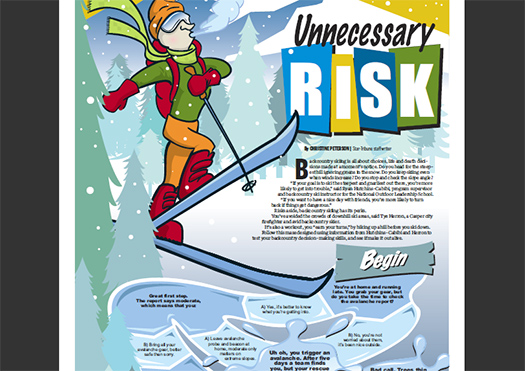WildSnow staff is headed outside today, but first we’re checking our heads with the mental maze below. Is it confusing us or helping? How is the emphasis? What do you guys think? See the whole thing here, over at the Casper Star Tribune. Once you’re done with this one, if you’ve not worked through our own avalanche safety quiz have a gander at that as well — anything helps that peels the lids of the avalanche eyeballs.
More avalanche news. A fatal avalanche in Montana a few days ago began with cornice fall. Reports indicate the skiers were attempting to climb an avalanche safe ridge-route when one man strayed a bit to far on what turned out to be the overhang of a cornice, which broke and took him down. Over the years, I’ve come to realize that snow cornices are one of the real gotchas of the alpine. Look back through history or talk to older alpinists, and the litany of cornice incidents is alarming. Experts are not immune. For example, famed pioneer climber Herman Buhl died in a cornice fall.
Most of you reading this have probably been in the situation. You’re on a ridge or summit and due to the gentle curve of a cornice edge you have absolutely no idea whether you’re next to a gigantic overhanging death trap, or a 10 inch drop onto a gentle slope. In terms of danger, the big cornices tend to garner more attention, but the small ones can be just as elusive and dangerous depending on what’s below.
I’ve never figured out a 100% solution for cornice travel, other than sometimes being ridiculously cautious and taking lines that add time and difficulty to the route, to avoid any chance of exposure. Problem is, sometimes topography will force you into a zone that might be hazardous, or the light is so bad you simply can’t figure out where to march. Roping up saves lives in these situations, but how many backcountry skiers are going to fiddle with ropes during a normal day, or how many even carry a rope and know how to use it? Gets you thinking.
I’m delighted at reports of new hut building endeavors here in Colorado, specifically in the Berthoud Pass area. Any of our huts near population centers and main transportation corridors are maxed out with thousands of user nights, so the more the merrier.
On the other hand, for what you get (a roof, a bathroom, a crowd, and a communal kitchen) I believe many of our huts are over priced and their popularity will wane as the backcountry skiing population’s tastes change. This due to a couple of factors. First, as gear becomes lighter weight and the uphilling ski population becomes more experienced, the huts end up “closer” to trailheads. Result is disincentive for use of the huts as overnight shelter. More, I know for a fact that many Colorado skiers are burnt out on the need for making reservations at most of the huts, along with the need to plan and pack their own victuals. So, when I read the report about the new Berthoud huts, one thing that leapt out at me was they are addressing the needs of day skiers by including a day-lodge room at the huts. If they make the step of providing some food and drink in those day lodges, in my view immense popularity will ensue. All in time, but inevitable?
WildSnow.com publisher emeritus and founder Lou (Louis Dawson) has a 50+ years career in climbing, backcountry skiing and ski mountaineering. He was the first person in history to ski down all 54 Colorado 14,000-foot peaks, has authored numerous books about about backcountry skiing, and has skied from the summit of Denali in Alaska, North America’s highest mountain.

